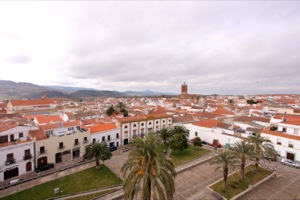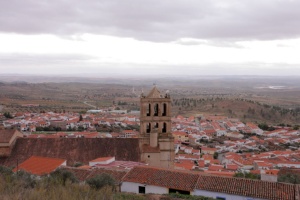Zafra, Jerez de los Caballeros and Fregenal de la Sierra
Zafra, Jerez de los Caballeros and Fregenal de la Sierra
These places are where the monumental and the gastronomic join hands
- Explore
- Zafra, Jerez de los Caballeros y Fregenal de la Sierra
Zafra, Jerez de los Caballeros and Fregenal de la Sierra
Art, architecture and gastronomy
-
These places are where the monumental and the gastronomic join hands
Nestling in the mountains south west of Badajoz you'll find three municipalities of great importance in the province of Extremadura and which have been declared Sites of Cultural Interest in the category of Historic-Artistic Sites.
Zafra, one of those cities which hides a thousand and one secrets, is known as Little Seville. The consolidation of the city was a result of its location as a strategic transit point on the Silver Way during Roman times and the presence of the Order of Santiago and the Duchy of Feria.
The Palace of the Dukes of Feria is most notable amongst its greatest treasures, in the surrounding area many remnants of medieval times can be seen. You can also visit the Santa Clara Museum, where the tomb of the II Duke of Feria is to be found.
In the centre of the town you'll find the Plaza Grande square, from which you get to the Plaza Chica square through the Arquillo del Pan archway.
In addition to the beautiful architecture you can also enjoy the art which is kept in the Church of La Candelaria, where you'll find an altarpiece by Zurbarán and another by Churriguera.
Zafra is also well known for its gastronomy and its International Livestock Fair, one of the most important in Europe.
Just over 30 kilometres from Zafra, you'll find Jerez de los Caballeros, declared an Historic Ensemble of Art and Monuments in 1966 and the birthplace of Vasco Núñez de Balboa, the discoverer of the Pacific Ocean. Here you can visit the Visitors' Centre dedicated to his history.
Nearby, we find the dolmen of Toriñuelo, of pre-Roman origin and declared a Historic National Monument. Jerez de los Caballeros is a city that breathes the presence of the Order of the Temple in many of its corners. You can admire the Temple Castle or Alcazaba, its Bloody Tower, without forgetting part of the wall surrounding the city and the six gates which allowed entrance to this city at that time: the Santiago Gate, Burgos Gate, Alconchel Gate, City Gate, New Gate and Seville Gate.
You mustn't miss the Santa María de la Encarnación Church either - the oldest temple in Jerez. On an upside-down column inside it, we can read that it was founded in the year 556 and that it seems to have been built on an old Visigoth basilica.
Special mention should be given to the Baroque-style religious and civil buildings, which, together with those suggesting a Renaissance and Moorish style, create an impressive stage to showcase its Easter Week festivities, declared Festivity of Regional Tourist Interest. A visit to the following, amongst others, is a must: the churches of Santa Catalina, San Bartolomé and San Miguel.
And of its numerous palaces and stately homes belonging to noble families and mayors, you can't miss the Casa del Sol, where the Tourist Office is located; the palaces of Guzmán Sotomayor, of the Marquises of San Fernando, of Martínez de Logroño or of the Vicarage, amongst others, and the Casa del Solar of the Counts of Berrona, Solar of the Quevedos, that of the Counts of the House of Ayala, and that of Silva y Figueroa, to begin with.
Its convents likewise deserve special attention. You can't leave without first seeing the Convent of Gracia, the Madre de Dios Convent or the San Agustín Convent, amongst others, and finishing up with the Nuestra Señora de la Luz Convent. Along the way, you'll come across some women's religious houses, such as the Esperanza, and hermitages, such as the Venerable Isabel de la Cruz, the Espíritu Santo or the San Gregorio.
Fregenal de la Sierra is another of the towns we recommend visiting. The castle-fortress is of great interest and importance, its first references dating back to 1253. The interior serves as a bullring and a market place. The Church of Santa María adjoins the entrance to the castle. The churches of Santa Ana and Santa Catalina are also of great value. The International Mountain Festival has been declared a Fiesta of Regional Tourist Interest.
This area has a very varied gastronomy, the black Iberian pig is a key ingredient in its cuisine, with typical dishes such as "guarrito frito" (fried pork), cold cuts, acorn-fed Iberian ham, all accompanied by good wines, liqueurs and the typical desserts of the region.
-
- Distance:
- 65 km
- Difficulty:
- Easy
- Time:
-
- Three days
Theme:
- Art and culture
- Destinations
- Nature areas
- Leisure
Type of Transport:
- Motor vehicle

a Zafra — stately and market-like
Situated in the south of Extremadura, Zafra is a charming town, and one buzzing with life thanks to the hospitality of its inhabitants, known in Spanish as "Segedanos".
Location:
Plaza de Pilar Redondo Zafra , Badajoz (Extremadura)

